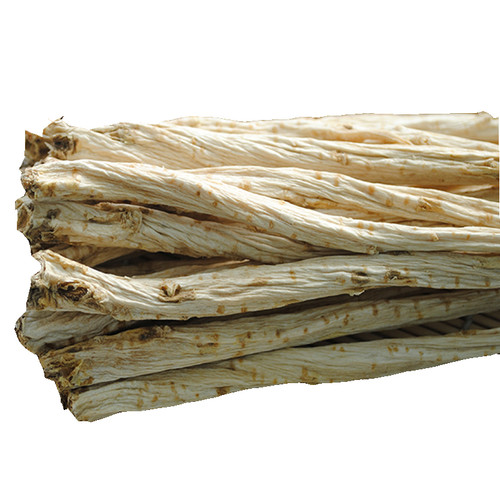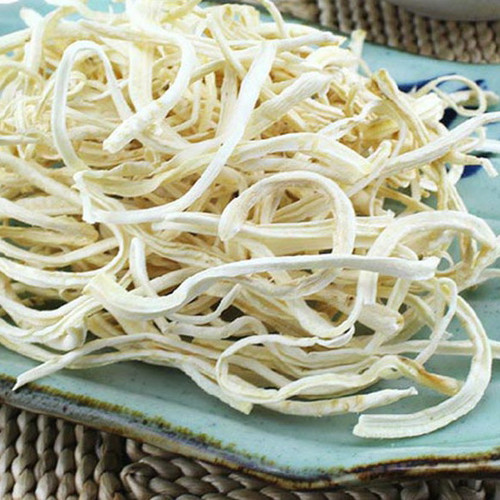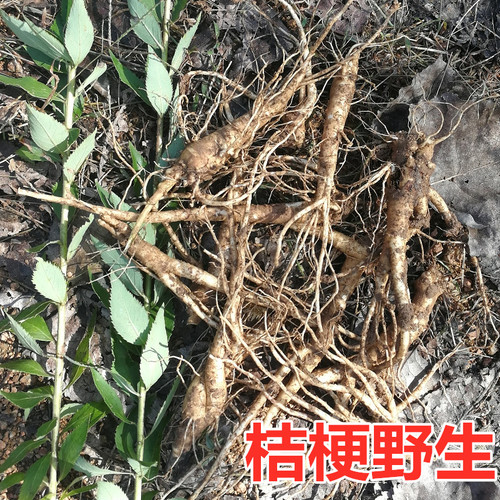Product Overview
Parts used: Dried root
TCM category: Warm herbs that transform Phlegm and stop Cough
TCM nature: Neutral
TCM taste(s): Bitter Pungent
Meridian affinity: Lung
Scientific name: Platycodon grandiflorus
Other names: Balloon flower, Chinese bellflower, Bellflower, Doraji
Use of platycodon roots (Jie Geng) in TCM
Please note that you should never self-prescribe TCM ingredients. A TCM ingredient is almost never eaten on its own but as part of a formula containing several ingredients that act together. Please consult a professional TCM practitionner, they will be best able to guide you.
Preparation: Dig out the root in the spring or autumn seasons, wash it, remove the fibrous elements, peel the skin and dry it. Remove impurities, wash again, soak in water, cut in thick pieces and dry.
Dosage: 3-10g.
Main actions according to TCM*: Opens the Lungs and smoothes the flow of Lung Qi. Expels Phlegm and pus from the Lungs and throat, can be used for either Wind-Cold or Wind-Heat according to the other herbs in the formula. Directs the actions of other herbs to the Upper Warmer.
Primary conditions or symptoms for which platycodon roots may be prescribed by TCM doctors*: Coughing Common cold Tonsillitis Chest congestion Sore throat Lung abscess
Contraindications*: This herb should not be used if there is blood in the expectoration and so is often not appropriate for tuberculosis.
Common TCM formulas in which platycodon roots are used*:
For Wind-Cold cough combine platycodon roots with tangerine peel (Chen Pi), apricot seeds (Xing Ren) and perilla leaves (Zi Su Ye).
For Wind-Heat cough combine platycodon roots with mulberry leaves (Sang Ye), apricot seeds (Xing Ren) and snake gourds (Gua Lou).
For sore throat and hoarse voice combine platycodon roots with ningpo figwort roots (Xuan Shen), liquorice (Gan Cao) and greater burdock fruits (Niu Bang Zi).
For swollen and painful sore throat combine platycodon roots with honeysuckle flowers (Jin Yin Hua) and greater burdock fruits (Niu Bang Zi).
For Lung and Kidney Yin Deficiency associated with chronic bronchitis, asthma or chronic pharyngitis combine platycodon roots with lily bulbs (Bai He), prepared rehmannia (Shu Di huang), unprepared rehmannia (Di Huang), dwarf lilyturf roots (Mai Dong), white peony roots (Bai Shao), dong quai (Dang Gui), ningpo figwort roots (Xuan Shen), fritillary bulbs (Chuan Bei Mu) and liquorice (Gan Cao).
For Exterior Wind-Heat with symptoms of headache, colds, sore throat combine platycodon roots with wild mint (Bo He), chrysanthemum flowers (Ju Hua) and greater burdock fruits (Niu Bang Zi).
For External Wind Heat with fever, sore throat, chills and red eyes combine platycodon roots with mulberry leaves (Sang Ye), chrysanthemum flowers (Ju Hua), forsythia fruits (Lian Qiao) and wild mint (Bo He).
For aiding in the withdrawal from tobacco addiction combine platycodon roots with houttuynia (Yu Xing Cao), ginseng (Ren Shen), mulberry bark (Sang Bai Pi) and snake gourds (Gua Lou).
For severe colds, flu or upper respiratory tract infections combine platycodon roots with honeysuckle flowers (Jin Yin Hua), forsythia fruits (Lian Qiao), greater burdock fruits (Niu Bang Zi), wild mint (Bo He), fermented soybeans (Dan Dou Chi), lophatherum herbs (Dan Zhu Ye), common reed rhizomes (Lu Gen), liquorice (Gan Cao), notopterygium roots (Qiang Huo) and woad roots (Ban Lan Gen).
For Lung Heat combine platycodon roots with loquat leaves (Pi Pa Ye) and mulberry leaves (Sang Ye).
For bronchial ulcerations combine platycodon roots with croton fruits (Ba Dou) and anemarrhena rhizomes (Zhi Mu).
For unsuppurated pus-filled sores combine platycodon roots with angelica roots (Bai Zhi).
For hot phlegm and lung abscess combine platycodon roots with wax gourd (Dong Gua), houttuynia (Yu Xing Cao) and honeysuckle flowers (Jin Yin Hua).
Key TCM concepts behind platycodon roots (Jie Geng)'s properties
In Traditional Chinese Medicine (TCM), platycodon roots are plants that belong to the 'Warm herbs that transform Phlegm and stop Cough' category. In TCM Phlegm is a condition of Stagnation of Fluids which tends to start in the Spleen and then goes to the Lungs. If this overly accumulates it thickens and becomes pathological Phlegm. Phlegm, being a form of Stagnation, often starts as being Cool and transforms to Hot as the condition progresses. The herbs in this category are Warm in nature so they treat the early stages of the Stagnation: Cold-Phlegm and Wet-Phlegm with symptoms of wheezing, vomiting and nausea.
As suggested by its category platycodon roots are plants that are Neutral in nature. This means that platycodon roots typically don't affect the balance in your body. Balance between Yin and Yang is a key health concept in TCM. Eating too many "Hot" (Yang) ingredients can lead to an imbalance whereby one has a Yang excess. The inverse is true as well: too many "Cold" (Yin) ingredients can lead to a Yin excess. The Neutral nature of platycodon roots means that you don't have to worry about that!
Platycodon roots also taste Bitter and Pungent. The so-called "five elements" theory in Chinese Medicine states that the taste of TCM ingredients is a key determinant of their action in the body. Bitter ingredients like platycodon roots tend to have a cleansing action on the body by clearing heat, drying dampness and promoting elimination via urination or bowel movements. On the other hand Pungent ingredients tend to promote the circulations of Qi and body fluids. That's why for instance someone tends to sweat a lot when they eat spicy/pungent food.
The tastes of ingredients in TCM also determine what organs and meridians they target. As such platycodon roots are thought to target the Lung. In addition to performing respiration, the Lungs are thought in TCM to be a key part of the production chain for Qi and the body fluids that nourish the body.
Use of platycodon roots (Jie Geng) as food
Platycodon roots are also eaten as food. It is used as an ingredient in dishes such as Doraji-muchim or Sauteed bellflower root.








